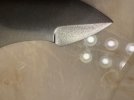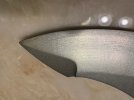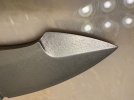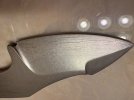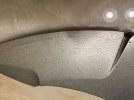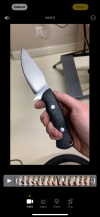t1mpani
Platinum Member
- Joined
- Jun 6, 2002
- Messages
- 5,527
`Hey everyone,
So this is one of my modified karambits that I've made quite a few of, out of 3/16" AEB-L, HT to 61.5 by Peter's HT, and though I got it back a few months ago I'm just getting around to finishing this one. I used a green scotch brite belt to clean the HT coloring off of it, just a few seconds on a side (and my thumb is always on the opposite side of the blade so it never gets all that hot) and then cleaned it up, etched it, and put it in the rocks to tumble. When I took it out, there were some longitudinal scratches that I THOUGHT were possibly from shoving the knife into the rocks too hard, so I kind of repeated the scotchbrite cleanup, etch etc and then gently set the knife in with the stones and covered it up, did a tumble again, and this time the lines are EXTREMELY prevalent. They seem to follow the contours of the blade, especially around the plunge lines. Have you ever seen anything like this? Could the acid etch have damaged the steel in such an odd way?
Thanks very much in advance,
Warren
So this is one of my modified karambits that I've made quite a few of, out of 3/16" AEB-L, HT to 61.5 by Peter's HT, and though I got it back a few months ago I'm just getting around to finishing this one. I used a green scotch brite belt to clean the HT coloring off of it, just a few seconds on a side (and my thumb is always on the opposite side of the blade so it never gets all that hot) and then cleaned it up, etched it, and put it in the rocks to tumble. When I took it out, there were some longitudinal scratches that I THOUGHT were possibly from shoving the knife into the rocks too hard, so I kind of repeated the scotchbrite cleanup, etch etc and then gently set the knife in with the stones and covered it up, did a tumble again, and this time the lines are EXTREMELY prevalent. They seem to follow the contours of the blade, especially around the plunge lines. Have you ever seen anything like this? Could the acid etch have damaged the steel in such an odd way?
Thanks very much in advance,
Warren

